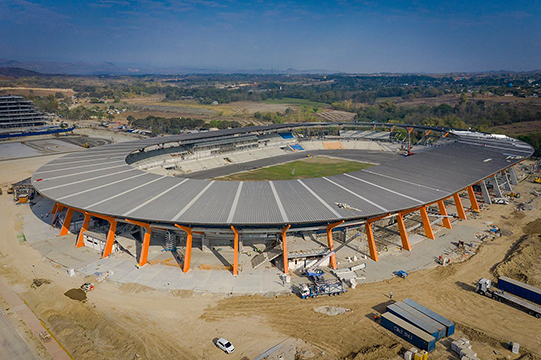CLARK FREEPORT — Will the New Clark City, which dropped the term “green” in its initial name, eventually sink as fast as it is rising?
Fear of such scenario is now being triggered by scientific findings of international and local groups that Pampanga and Bulacan, among other areas in the country if not worldwide, are sinking at the rate of five centimeters or more annually mainly due to over extraction of groundwater.
While the New Clark City is located in Capas, Tarlac north of Pampanga, the reason cited for subsidence of the two provinces could be the way the new city is heading.
This, amid apparent lack of parallelism between the rise of structures to accommodate the city’s future population and the effort to construct facilities that would fulfill the population with a need as basic as water provided by surface sources.
Such fault has been tagged as culprit in the sinking of such great cities as Alexandria which is Egypt’s main port city, Miami and New Orleans in the US.
Tianjin in China where coastlines have already sunk by nine feet, and Jakarta in Indonesia where sections are sinking at the rate of 9.8 inches per year.
Indeed, paeans are being sung for what the Bases Conversion Development Authority (BCDA) are accomplishing at the New Clark City, particularly the almost completed sports complex to be used for the Southeast Asian Games this yearend and the new government center where central offices of national government agencies would be transferred.
The BCDA, in its initial media briefings, had cited tapping surface water in the area of Mt. Pinatubo to provide for the needs of the new city which is reputed to be way above sea level and therefore immune from flooding.
Then came last year the announcement that locators and residents of the New Clark City would enjoy a low water rate of P9.45 per cubic meter following the awarding of the water and wastewater infrastructure project to a consortium led by PrimeWater Infrastructure Corp.
And there has been no word on concrete actions to tap surface water sources.
The BCDA was reported to have signed a joint venture agreement (JVA) on December 17 with the four-member consortium. The other three members are Prime Assets Venture, Inc., MGS Construction, Inc., and the Tahal Group.
The consortium submitted the lowest bid of P9.45 per cubic meter, besting the P11 per cubic meter bid by the Manila Water Company.
With the SEA Games to launch on Nov. 30 this year, it is only too easy to posit that water supply for the venue within the New Clark City would be sourced from underground.
Over-extraction
The University of the Philippine National Institute of Geological Sciences also has reported that land, which include entire towns, in Pampanga and Bulacan are sinking mainly due to over-extraction of groundwater and these areas are sinking at a rate of five centimeters annually.
Guagua town alone is said to be sinking between two centimeters every year along with Sasmuan town which has been sinking at a rate of two to four centimeters yearly, or about a meter in 20 years.
The DENR, in 2007, reported that saline water intrusion has also affected at least 23 kilometers of the Pampanga River and its 45 kilometers inland.
The steady sinking of coastal towns and islets in the northern Philippines has caused Manila Bay’s brackish water to pour inland and displace thousands, posing a greater threat than rising sea levels due to climate change.
The provinces of Pampanga and Bulacan – where Pariahan, an island sitio in Bulakan town that has gone totally underwater is located – have sunk between 4cm and 6cm annually since 2003, according to satellite monitoring.
“It’s really a disaster that is already happening. It’s a slow-onset disaster,” explained Narod Eco, who is part of a group of scientists tracking the problem.
By comparison, the UN estimates average sea level rise globally is about 3mm per year.
The sinking is very likely permanent because the ground in the hardest hit areas is mostly clay, which sticks together after the water is pulled out.
A moratorium on new wells in the greater Manila area has been in place since 2004, the National Water Resource Board has only about 100 staffers to ensure compliance.
New Clark City, located within the Clark Special Economic Zone, is envisioned to be the first smart, green, and sustainable metropolis in the country.
The BCDA, in a statement last year, said PrimeWater has over 30 years of proven experience in providing safe and reliable water distribution systems throughout the country. It operates in 124 cities and municipalities from the Cagayan Province in the north to Zamboanga City in the south.
Its partner, Israel- based Tahal, has been delivering world-class solutions across the fields of water, wastewater, agriculture, solid waste and natural gas for over 60 years.
National Geographic
The same glaring boasts had been made by water companies in sinking big cities.
Last March, National Geographic magazine noted that “cities are slowly sinking for a number of reasons, both man-made and natural. These range from rising sea levels to subsistence in metropolises caused by the weight of buildings and people, and the interaction of geological and climatic factors. The Iranian capital of Tehran is sinking at a particularly alarming rate, with around 10 percent of its area affected. The airport is also subsiding at a rate of two inches a year.”
“Across the pond, NASA/European Space Agency data suggests parts of a 444-mile aqueduct in California sank over 23 inches from 2013 to 2016. California’s San Joaquin Valley — whose cities include Stockton and Fresno — is sinking by the same amount per year, too,” the publication noted.
In their study titled “Worsening Floods around Northern Manila Bay, Philippines: Research- Based Analysis from Physical and Social Science Perspectives,” scientists K.S. Rodolfo, F.P. Siringan, C.T. Remotigue, and C.B. Lamug noted that “dewatering and subsidence are greatly accelerated by heavy extraction of groundwater for fishponds, farms, and the rapidly growing population. Annual subsidence of several centimeters measured at many Pampanga well-sites has been independently confirmed by recent geodetic resurveys.”
“The excessive use of groundwater has been attributed as the main cause of subsidence and saltwater intrusion. Groundwater is sourced from aquifers, water-filled sandy layers underground, which are recharged from rain water seepage.
However, over-extraction lessens the pressure in the aquifers and the clay layers above and beneath them which results into compaction and subsidence of surface land,” the study said.
It can be noted that farming alone has been found to contribute greatly to groundwater extraction, as Pampanga is also a major producer of rice that requires substantial amount of water for production. It takes around 1,432 liters of water to produce 1 kilogram of rice in an irrigated lowland production system, studies showed.
But with various industries and tourism establishments expected to pour into the New Clark City, on top of those already at the Clark main freeport, the demand for water would be quite heavy.
Studies have estimated 12 towns and cities in Pampanga could experience groundwater shortage by 2025 due to unchecked proliferation of deep wells in houses and industries.




